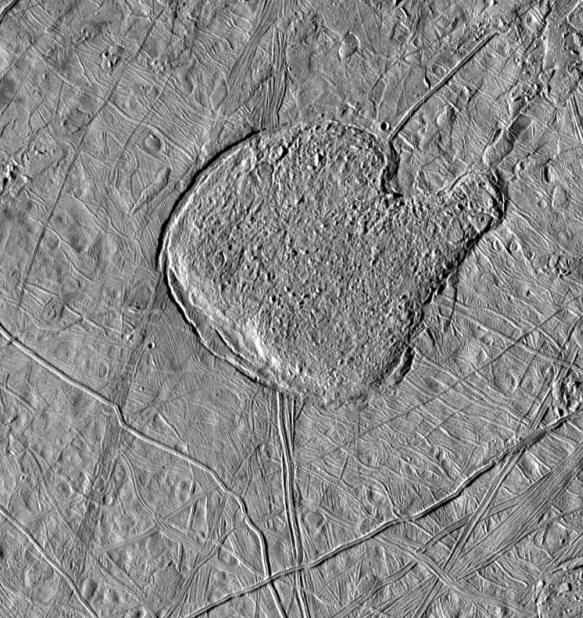It
appears as if the north and south
poles on Jupiter's giant moon are no
longer located where they
originated.Scientists have been studying images returned by the Galileo spacecraft for
almost ten years now. The images transmitted from Jupiter's moons, in
particular, revealed structures that seem to defy conventional geological
theories. Why is Callisto covered with craters? Why does Ganymede possess a
magnetic field? Why does Europa appear to be covered with water ice that is
floating on a vast ocean?
A May 15, 2008 article in the science journal Nature announced that
Europa seems to have experienced displacement of its north and south poles on
more than one occasion. Some close-up observations of its surface reveal giant
circular and arcuate formations that researchers interpret as coming from faults in the
crust. As prevailing opinions suggest, Europa's surface is a multi-kilometer
deep shell of water ice floating on a salty sea. The "decoupled" surface
undergoes periodic deformation because movement of the ice creates
stress cracks, allowing gigantic rafts to form.
The ice rafts supposedly move freely around the moon, pulling apart from one
another and then crashing into each other as they are disturbed by heat coming
from the interior. In general, Europa is thought to have a hot core because the
gravitational forces from Jupiter are said to be stretching and squeezing the
moon, creating enough friction to melt the subsurface ice. Crustal displacement
due to convection in the liquid layer is responsible for the development of
"strike slip faults" that do not conform to the predictive models,
according to Alyssa R. Sarid, a graduate student at the University of
Arizona, and her advisor Richard Greenberg.
"With its thin ice shell over a global ocean, Europa is unique. The strike-slip
motion provided the key to what has been going on," Sarid reported. Greenberg
agrees: "What this suggests is that nothing keeps the thin ice shell of ice
covering Europa from sliding around -- it is free to slip and slide over the
underlying ocean. The result is the first confirmation that the crust does
wander relative to the poles of rotation."
In 1989, a theory was published about the potential for Europa's poles to wander
over the surface. "Tidal friction" was tapped as the perpetrator – interior heat
makes the ice at the equator thinner than at the poles. Europa's rotational
momentum pushes thicker polar ice toward the equator carrying the geographic
poles with it. Sarid and Greenberg's research concludes that the ice laid down
millions of years ago at the poles is now oriented 30 degrees closer to the
equator. The implication is that the processes taking place on Europa are
invisible to direct observation since they require immense periods of time for
their actions to produce significant effects. What kind of experimental project
could confirm this hypothesis?
Cracks more than a kilometer deep stretch across the moon from horizon to
horizon. Dual ridges bracket flat-bottomed faults and wide, dark bands trace out
swaths of contrasting material over two thousand kilometers long.
The proposition is that Europa is much like the Arctic Ocean here on Earth
and the features we see here can be translated to those we see there.
Continental drift and plate tectonics assumptions are used both to explain what
has been discovered on Europa and to use Europa as confirmation of the theory, a
technique known as "bootstrapping". However, as
previous Picture of the Day articles have demonstrated, Europa could have
reached its present shape in a short period of time and in the relatively recent
past.
The looping rilles on Europa have no analog to ice cracks on Earth. When ice
breaks it is chaotic and affected by variations in thickness and composition so
repetitive patterns over long distances should not be expected. Yet, repetitive
patterns are observed on Europa, especially in the
cycloidal rilles called "flexi". The swirls and loops that cover the moon
might lend themselves to duplication in the laboratory using plasma discharge
equipment, although at present there are no known experiments of that nature
scheduled. It seems evident, though, that whatever happened on Europa in the
past is not happening today (thus the long time scales required by standard
theories).
Greenberg's team from the University of Arizona is building an edifice on top of
unstable foundations. Ice is far more homogeneous than rock, so surface
discharges on Europa might have excavated the straight trenches. If electric
arcs were released in the presence of a magnetic field parallel to the surface,
circles or partial circles might be cut into the lithosphere. Claiming that
rotation, gravity and melting ice are what shaped Europa and are slowly
continuing to do so beyond the limits of our perception means that important
factors are being ignored by scientists analyzing observational data.
As long ago as 2005, the Thunderbolts team
commented on the ironic nature of NASA investigations – but they seem to be
continuing in the same vein today.
"What is needed in the case of Europa’s surface mysteries is not an arbitrary
computer-generated 'solution', but practical experiments to test a new
hypothesis. Can electrical discharges produce the rille patterns seen on Europa?
The required experimental work is easily within reach if NASA’s investigators
will follow evidence already in hand. The resulting insights could change the
direction of planetary science."
By Stephen Smith







